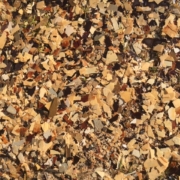Dispatch from the Sugarwoods, 3/24/20
As I write this, about 4 inches of fresh snow are glowing bluely in the predawn light.
The season continues for us. The mid-week freeze last week brought a nice color back to the syrup, and the flavor was as good as any we’d made all year. The warmth last Friday definitely took its toll – the sap flow has slowed. But it ran decent this past weekend; it even ran during Monday’s storm. “Sugar snow,” the old-timers called these March runs, when the thermometer hovers around 30°, and big wet snowflakes dapple and droop tree limbs, and defying all physics the sap flows anyway.
We’re at about ¾ of a crop, and it’s taken us 63 gallons of sap to make each gallon so far. As a comparison, last year was 51:1, which is closer to our long-term average. So things this year are significantly less sweet.
Why do trees vary in sugar content from year to year? There are so many variables that no one can say for sure. Two years ago our sugar content also averaged 63:1, and I decided then that it related to a drought in 2016, which produced a stress crop of seeds in 2017, which depleted the tree’s sugar reserves in the spring of 2018. Intuitively this kind of makes sense. You can test the starch reserves in a tree’s root system in the fall, and it’s documented that the reserves vary from year to year based on stress. (Testing of this sort is not standard practice in the industry – it’s mostly done in conjunction with an insect-related defoliating event, as it can give a sugarmaker an idea of tree health before the season so they can make the decision to tap or not.) You can read some work here from Harvard forest where they looked into the relationship between seed years and syrup yields.
We had a heavy seed year last summer, too. So maybe the same thing’s at play again. But I have a new theory this year I’m toying with, and it involves nighttime low temperatures. What we’re noticing, and it’s backed up by another producer I know with a high-vacuum system, is that when you spot check the sugar content of the sap after a hard freeze, it spikes up to 2-plus percent, where it should be. But then as days go by without a freeze, the sap gets progressively less sweet. If we look at the last two weeks, which were the heart of this season, we had a hard freeze (below 25°) on the 8th, followed by 6 nights where it either didn’t freeze or just touched freezing. If froze hard on the nights of the 15th and 16th, recharging the trees, but then it didn’t freeze hard again until the 22nd. So only three out of fourteen nights. When averaged, the low temperatures in that two-week window came out to 30.4°. Last year had consistently lower low temps. Nine of out fourteen nights in the 2-week heart of the season dropped below 25°, and the overall average was 26.7°.
So now I’m wondering if these middling low temps might be a contributing factor to the low sugar content as well. I talked with my friend Mark Isselhardt, the UVM extension maple specialist and a respected maple scientist, and asked his thoughts. He was buying the idea that the lack of hard freezes had an effect. He was skeptical of the seed theory.

